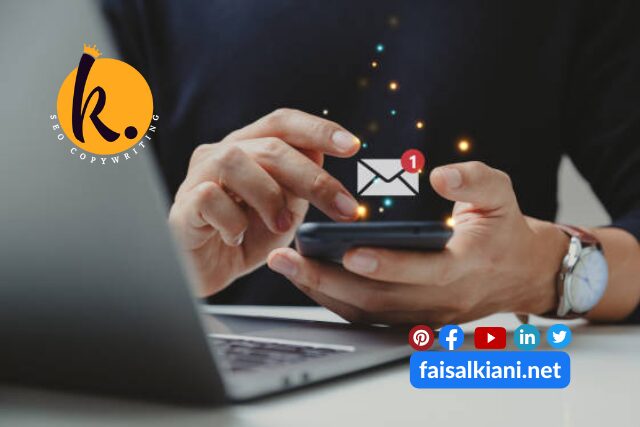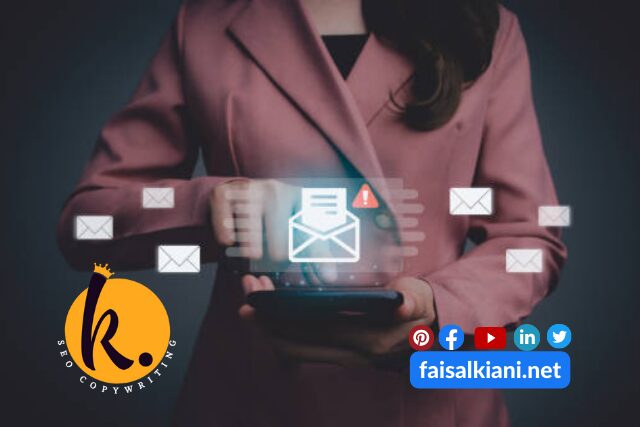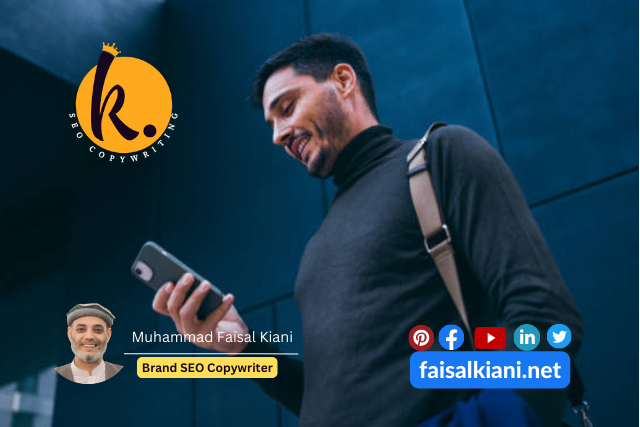Excited to learn how to write email copywriting, even as a beginner? Ever wondered how to make your messages stand out and spur people into action? Well, let me tell you the truth, it’s not as tricky as you might think. Nope, it’s not rocket science at all – I’m serious!
Sometimes, folks make things seem super complicated to emphasize their importance or to sell you on a fancy solution. But here’s the truth: crafting awesome email copywriting is totally doable.
So, let’s have a chat about the nuts and bolts of it all. Get ready for some practical tips and tricks that’ll have you creating emails people can’t wait to read and respond to!
How to Write Email Copywriting | A digital tool to Covert words into Actions

Have you ever stared at a blank email draft, wondering how to turn it into a click magnet? You’re not alone. Email copywriting can feel like a mysterious art, but fear not!
This masterpiece will equip you with the tools and strategies to write emails that captivate readers and drive results.
Why does Email Copywriting Matter?
Think of your email inbox as a bustling marketplace. Your message is a vendor trying to grab attention among a sea of others.
Well-crafted email copywriting is your secret weapon, making your message stand out and converting potential customers into loyal fans.
Here’s how powerful email copywriting benefits you:
- Boosts Engagement: Compelling copy grabs attention, encourages readers to open your emails, and keeps them hooked.
- Drives Action: Whether you want them to click a link, download a freebie, or make a purchase, clear calls to action (CTAs) are essential.
- Strengthens Relationships: Emails that provide value and build trust foster long-term relationships with your audience.
Building Your Email Copywriting Foundation
Before crafting captivating emails, let’s solidify your fundamental knowledge. Here are the building blocks of effective email copywriting:
- Knowing Your Audience: This is rule number one! Who are you sending emails to? What are their needs, challenges, and interests? Tailoring your message to resonate with them is crucial.
- Defining Your Goal: What do you want your email to achieve? Do you want subscribers to learn about a new product, attend a webinar, or make a purchase? Having a clear goal keeps your message focused.
- The Power of Storytelling: People connect with stories. Weaving narratives into your emails adds a touch of emotion, making them more memorable and engaging.
Now, let’s dive into the exciting world of subject lines and email structures!
Subject Lines: The Make-or-Break First Impression
Your subject line is the first thing your readers see. It’s like a movie trailer – it needs to be captivating enough to entice them to open the email and discover the full story. Here are some tips for crafting subject lines that grab attention:
- Keep it Short and Sweet: Aim for 50 characters or less to avoid getting cut off in inboxes.
- Spark Curiosity: Pose a question, tease a benefit, or use a surprising statement to pique interest.
- Personalize When Possible: Use subscribers’ names or segment your list to send targeted subject lines.
- Test and Refine: Subject line testing is crucial. A/B test different options to see what resonates best with your audience.
Examples:
- Generic: “New Products Available!”
- Curiosity-Driven: “Is This Mistake Costing You Sales?”
- Personalized: “[Name], Your Free Download is Waiting!”
now, let’s move on,
Crafting the Perfect Email Structure: A Blueprint for Success
Think of your email structure as a blueprint for a house. It needs to be well-organized, visually appealing, and guide readers through your message smoothly. Here’s a typical email structure breakdown:
- Preheader Text: This short snippet appears next to the subject line in some inboxes. Use it to further entice readers to open the email.
- Attention-Grabbing Introduction: Hook your readers from the get-go. Start with a compelling story, a surprising fact, or a question that directly addresses their needs.
- Body Content: This is where you flesh out your message. Keep it concise, use bullet points for easy scanning, and break up text with visuals.
- Clear Call to Action (CTA): Tell your readers exactly what you want them to do next. Whether it’s clicking a link, downloading a resource, or making a purchase, make your CTA prominent and easy to find.
- Professional Closing: Thank your readers for their time and include your contact information.
Bonus Tip: Always include an unsubscribe link in your emails. It shows respect for your subscribers’ choices and helps maintain a healthy email list.
The Power of Words: Weaving a Spell with Persuasive Language
Words are your paintbrush, and your email is the canvas. By mastering the art of persuasive language, you can paint a picture that compels readers to take action. Here are some key techniques:
- Focus on Benefits, Not Features: People care about what your product or service does for them, not its technical specifications. Highlight the benefits that solve their problems or improve their lives.
- Speak Their Language: Use the language your audience understands. Avoid jargon and technical terms that might leave them confused.
- Urgency and Scarcity: A gentle nudge can be powerful. Create a sense of urgency by highlighting limited-time offers or limited quantities.
- Social Proof: Testimonials, case studies, and customer reviews build trust and show readers that others have benefited from your product or service.
- Strong Verbs and Power Words: Choose action verbs that inspire movement. Sprinkle in power words that evoke emotions and create a sense of value.
Examples:
- Feature-Focused: “Our new software boasts a 99.9% uptime guarantee!”
- Benefit-Driven: “Never worry about downtime again with our ultra-reliable software!”
- Jargon Overload: “Our cutting-edge AI algorithms will synergize your marketing efforts!”
- Clear Communication: “Let our easy-to-use marketing tools help you reach new customers!”
Crafting Compelling CTAs: The Final Push
Your call to action (CTA) is the moment of truth. It’s where you ask your readers to take the next step. Here’s how to craft compelling CTAs that convert:
- Keep it Clear and Concise: Don’t leave your readers guessing. Use strong verbs like “download,” “learn more,” or “shop now.”
- Highlight the Benefit: Remind readers what they’ll gain by taking action.
- Strong Button Design: Make your CTA button visually appealing and easy to find.
- A/B Test Different Options: Experiment with different CTA wording and button designs to see what resonates best with your audience.
Bonus Tip: Personalize your CTAs whenever possible. Use subscribers’ names or tailor them to their specific needs.
Bonus Resources:
- Headline Hacks: Copyblogger’s famous blog post offers a treasure trove of tips for crafting irresistible headlines, which can be easily adapted to email subject lines.
- The Hemmingway Editor: This free online tool helps you write clear and concise prose by highlighting complex sentences and potentially overused words.
- EmailOctopus Subject Line Tester: This tool from a popular email marketing platform allows you to test different subject lines and see which ones are predicted to perform best.
Advanced Email Copywriting Techniques:
- Segmentation: Don’t blast the same message to everyone. Segment your email list based on demographics, interests, or purchase history to send targeted emails that resonate more deeply.
- Personalization: Go beyond just using names. Use data to personalize the content of your emails, creating a more one-on-one experience.
- Storytelling Powerhouse: Weave storytelling throughout your emails, not just in introductions. Use stories to illustrate benefits, connect emotionally with readers, and make your emails more memorable.
- A/B Testing Champion: Don’t settle for assumptions. A/B test different elements of your emails, like subject lines, CTAs, and email structure, to see what drives the best results.
Remember: Email copywriting is an ongoing journey of learning and experimentation.
Here are some additional tips to keep you on top of your game:
- Stay Inspired: Read successful email marketing campaigns and analyze what makes them effective.
- Seek Feedback: Ask colleagues or friends to review your emails and provide constructive criticism.
- Track Your Results: Monitor your email metrics like open rates, click-through rates, and conversions to see what’s working and what needs improvement.
- Embrace New Trends: The world of email marketing is constantly evolving. Stay curious and learn about new trends and best practices.
So, keep crafting those compelling emails, and watch your audience and your business flourish.
Email Copywriting Types | A Must-Read Before Writing Email Copy

Email writing is like a toolbox full of different tools, each suited for a different job in your email marketing plan.
Let’s explore some of the common types:
Transactional Emails:
Welcome Emails: Say hi to new subscribers and introduce them to your brand. Sometimes, you even give them special deals to make them feel welcome.
Order Confirmation Emails: Thank customers for buying something and tell them when it’s coming. You might even suggest other things they might like. S
hipping Notifications: Let customers know when their stuff is on the way and how they can track it.
Password Reset Emails: Help customers who forgot their password get back into their accounts.
Account Update Emails: Tell customers if something changes on their account, like their payment info or new features they can use.
Promotional Emails
Product Launch Announcements: Get people excited about something new you’re selling by telling them all about it.
Flash Sale Emails: Offer big discounts, but only for a short time to make people hurry up and buy.
Seasonal Campaigns: Send special emails for holidays or other big events, with deals and fun stuff.
Abandoned Cart Reminders: Remind people about stuff they left in their shopping cart, maybe even offering a discount to convince them to buy.
Relationship Building Emails
Newsletter Emails: Keep people in the loop with news, tips, or interesting stuff happening in your industry.
Educational Emails: Teach people things related to what you sell, making them trust you even more.
Event Invitations: Invite people to cool events you’re hosting, like webinars or workshops.
Survey Emails: Ask people what they think about your stuff so you can make it even better.
Birthday or Anniversary Emails: Send personalized wishes and maybe even a little gift on their special day.
Remember, there are more types out there, and sometimes they mix together. The important thing is to pick the right type for what you want to achieve!
Email Copywriting Mistakes and Solutions

Alright, warriors! You’ve conquered email copywriting bootcamp. Now, armed with killer strategies, you’re ready to craft magnetic messages that captivate audiences and drive results.
But hold on a sec, let’s dodge some common pitfalls before you unleash your email awesomeness.
1. Ignoring Your Audience: They’re Not Mind Readers!
Mistake: Blasting generic emails like “Hey there!” with irrelevant content.
Solution: Imagine your ideal customer. What are their challenges? What keeps them up at night? Craft targeted messages that speak directly to their needs. For example, if you sell fitness apparel, personalize your email with: “Hey runners, feeling frustrated about chafing? We’ve got the perfect solution!”
2. Missing in Action: Goals & CTAs
Mistake: Sending emails with no clear purpose. Readers are left wondering, “What do you want me to do?”
Solution: Define a goal for each email! Do you want them to download a free guide, register for a webinar, or make a purchase? Craft a compelling call to action (CTA) that beckons them to take the next step. Instead of a bland “Learn More,” use an action-oriented CTA like “Download Your Free Training Guide Now!”
3. The Snoozefest: Forgettable Content
Mistake: Droning on with text-heavy emails that nobody wants to read.
Solution: Liven things up! Infuse your emails with engaging storytelling, captivating visuals, and actionable content. Break up text with bullet points, bold important information, and use images or GIFs to keep readers engaged. Imagine you’re writing a captivating story, not a textbook chapter.
4. Subject Line Sabotage: The First Impression
Mistake: Using boring subject lines like “Company Update” or “Important Information.”
Solution: Craft curiosity-driven subject lines that spark interest and entice readers to open your email. Think of it like a movie trailer – create a sense of intrigue with clear, concise, and intriguing language. For example, instead of “Company Update,” try “New Feature Alert: Level Up Your Workouts Here!”
5. Structural Shenanigans: Confusing Your Readers
Mistake: Having an email structure that’s cluttered, disorganized, and visually unappealing.
Solution: Think of your email structure as a user-friendly website. It should be visually appealing, well-organized, and guide readers through your message with ease. Use clear layouts, keep content concise, and break up text with visuals to create a scannable experience. Imagine your inbox is a crowded city – make your email stand out with a clean and easy-to-navigate design.
6. Jargon Jungle: Speak Their Language
Mistake: Drowning readers in technical jargon and industry lingo.
Solution: Avoid technical jargon and industry lingo that might leave your readers scratching their heads. Use clear, concise language that your target audience can easily understand. Remember, you want to connect with them, not confuse them. Instead of “leverage our synergistic functionalities,” explain how your product “helps you achieve your goals in a simple and effective way.”
7. Powerless Persuasion: Missing the “Why”
Mistake: Focusing only on features and neglecting the benefits.
Solution: Don’t just list features – focus on benefits! Highlight how your product or service solves their problems and improves their lives. Use persuasive language that emphasizes the “why” behind your offering and inspires action. Instead of saying “Our blender has 20 speed settings,” showcase the benefit: “Get perfectly smooth smoothies every time with our powerful blender!”
8. The Hermit Approach: Ignoring Social Proof
Mistake: Failing to leverage social proof like testimonials and customer reviews.
Solution: People trust recommendations. Leverage social proof like testimonials, case studies, and customer reviews to build trust and showcase the value you provide. Let your happy customers do the talking for you! Include quotes like: “‘This product is a game-changer!’ – Sarah K.”
9. A/B Testing Neglect: Missing Out on Optimization
Mistake: Settling for assumptions and not testing different elements of your emails.
Solution: Don’t settle for assumptions! A/B test different elements of your emails, like subject lines, CTAs, and content, to see what resonates best with your audience. Embrace the data and continually refine your email copywriting for maximum impact. Test different subject lines to see which ones get the most opens!
10. Design Disasters: Confusing Aesthetics
Mistake: Using jarring color schemes, overly-sized fonts, or unprofessional layouts.
Solution: Maintain a consistent and professional brand aesthetic in your email design. Choose colors that complement your brand and ensure fonts are easily readable on all devices. Imagine a visually appealing store – your email design should be inviting and easy on the eyes.
11. Inconsistent Branding: A Disconnect
Mistake: Having a brand voice in your emails that doesn’t match your overall brand identity.
Solution: Maintain a consistent brand voice throughout your emails, just like you would in your other marketing materials. Are you playful and conversational? Authoritative and informative? Define your brand voice and stick to it for a cohesive experience.
12. Image Overload: Information Avalanche
Mistake: Stuffing your emails with too many images that overwhelm readers and slow down loading times.
Solution: Use high-quality images strategically to enhance your message, not replace it. Keep image file sizes small for faster loading times. Think of visuals as supporting actors, not the main event in your email.
13. Mobile Mishap: Ignoring the Small Screen
Mistake: Sending emails that aren’t optimized for mobile devices, where most emails are actually opened.
Solution: Ensure your emails are mobile-friendly with responsive design. Use clear fonts, single-column layouts, and large buttons for easy clicking on smaller screens. Imagine your email on a tiny phone screen – is it still clear and easy to navigate?
14. Frequency Faux Pas: Bombarding Your Audience
Mistake: Bombarding your audience with too many emails, leading to unsubscribes and frustration.
Solution: Develop a strategic email marketing plan with a defined sending frequency. Segment your audience and tailor emails to their interests to avoid generic blasts. Remember, quality over quantity! It’s better to send fewer, high-value emails than a constant stream of irrelevant messages.
15. Personalization Pitfall: Missing the Mark
Mistake: Using generic personalization tactics like “Hey [First Name]” without any real relevance to the recipient.
Solution: Personalize your emails beyond just names. Leverage purchase history, browsing behavior, or past interactions to craft targeted messages that resonate with each recipient. For example, instead of a generic “Hey Sarah,” use “Hi Sarah, we noticed you viewed our hiking boots. Check out these new trail-ready styles!”
16. Accessibility Oversights: Leaving People Behind
Mistake: Neglecting to make your emails accessible to people with disabilities.
Solution: Use alt text for images, ensure proper color contrast, and avoid using overly complex layouts. This allows everyone to enjoy your emails, regardless of their abilities.
17. Broken Links: Frustration Stations
Mistake: Including broken links in your emails that lead to error pages.
Solution: Always double-check and test all links in your emails before sending. There’s nothing worse than sending someone on a wild goose chase with a broken link.
18. Unsubscribe Sabotage: Making it Difficult to Leave
Mistake: Making it difficult for people to unsubscribe from your emails if they no longer want them.
Solution: Always include a clear and easy-to-find unsubscribe link in every email. A frustrated subscriber who can’t unsubscribe is more likely to report you as spam.
19. Spam Trigger Traps: Unintentional Spam Signals
Mistake: Using excessive exclamation points, ALL CAPS text, or spammy language that triggers spam filters.
Solution: Maintain a professional tone and avoid spammy tactics. Focus on building trust and providing value with your emails.
20. Measurement Neglect: Flying Blind
Mistake: Failing to track your email marketing results and analyze what’s working and what’s not.
Solution: Utilize email marketing analytics to track key metrics like open rates, click-through rates, and conversion rates. Use this data to refine your strategy and improve your email copywriting for future campaigns.
Email copywriting with Sales Funnels | The Secret of a Sales Cycle

Understanding the Sales Funnel Stages:
The sales funnel is like a map showing how people go from hearing about something to buying it. Here are the stages and how email writing helps at each step:
Top of Funnel (TOFU):
Goal: Letting people know about your brand and making them trust you. Email Writing Ideas: Welcome emails for new friends. Teaching emails about things they care about. Updates about stuff they might like.
Middle of Funnel (MOFU):
Goal: Keeping people interested and excited. Email Writing Ideas: Stories about people who love your product. Free things to try out or learn about. Comparisons with other things to show why yours is best.
Bottom of Funnel (BOFU):
Goal: Making people buy your product. Email Writing Ideas: Special deals that don’t last long. Suggestions for things they might like based on what they’ve looked at before. Reviews from happy people to show how great your product is.
Crafting Great Email Writing for Each Stage:
Here’s what to think about when writing emails at each step:
TOFU: Make your emails interesting and helpful to show you know your stuff and can help with their problems.
MOFU: Give away cool stuff or show how your product can make their life better. Answer their questions and show why your product is the best.
BOFU: Make people want to buy now with offers that won’t last forever. Use reviews and stories to make people trust your product. Make it easy for them to buy.
Example:
Imagine you sell workout clothes. Here’s how you’d write emails for each step:
TOFU: Emails about different workouts and why they’re good for you.
MOFU: An email with a guide on picking the right workout clothes and showing off your cool clothes.
BOFU: An email about a sale on leggings, with reviews from happy customers and a special discount code.
So, match your emails with the sales funnel. It’ll help guide people from just hearing about your product to loving it and buying it.
Emails are a great way to build relationships and turn people into fans of your brand. And don’t forget to check out Kaydot for tips on getting started with email writing!
The Best Email Copywriting Niches – How to Find and Use Them?

Now, get ready to dive into the juiciest email copywriting niches. Here’s a starting guide:
- Identify Your Interests: What gets you buzzing? Whether it’s tech, travel, or health, find your passion.
- Research the Market: Scope out where the money’s flowing. Financial services, tech, and health are hot spots.
- Match Skills with Niches: Got a knack for words in a particular field? Capitalize on it!
- Explore Diverse Opportunities: Don’t stick to one niche. Test the waters and see what clicks.
- Network Like a Pro: Rub shoulders with industry pros and keep your ear to the ground for new opportunities.
- Create Killer Samples: Show off your skills with top-notch samples tailored to your chosen niches.
- Pitch, Pitch, Pitch!: Don’t wait for opportunities to come knocking. Take the plunge and pitch your services.
Email Copywriting Niches
Ever wondered about the cool world of email writing? Let me spill the beans on some awesome niches:
- E-commerce: Think writing emails about those shiny new gadgets or trendy clothes you just gotta have.
- B2B Marketing: It’s like being a secret agent, but instead of gadgets, you’re selling products or services to other businesses.
- Content Marketing: Imagine sending out emails filled with exciting stories, videos, or podcasts.
- SaaS (Software as a Service): You get to explain how those nifty apps and software can make life easier.
- Financial Services: Writing emails to help folks with their money matters, like banks or insurance companies.
- Health and Wellness: Sending out tips to keep fit or reminders to drink water – healthy vibes all around!
- Education: Who said learning can’t be fun? Send emails with cool lessons or homework reminders.
- Travel and Hospitality: Get ready to whisk people away to dreamy destinations or cozy hotels with just your words.
- Nonprofits: Write emails that tug at the heartstrings, asking for help or sharing the amazing work being done.
- Real Estate: Show off stunning homes or help folks find their dream abode.
The Highest Paying Copywriting Niches
Now, hold onto your hats because here comes the exciting part – the highest paying gigs!
- Financial Services: Helping big companies with their money matters means big bucks for you!
- Technology: Writing about the latest gadgets and apps can land you some seriously fat paychecks.
- Health and Wellness: People will pay top dollar for advice on how to live their best, healthiest lives.
Don’t forget to head over to Kaydot for some awesome tips on snagging your first email copywriting gig. Trust me, you won’t want to miss out on those golden nuggets!
The Top Email Writing Niches to Begin Your Career
If you’re excited to start writing emails, here are some great niches to explore:
- E-commerce Email Copywriting:
- For those who love shopping and want to write about cool products.
- You can write emails about new stuff in online stores or special deals.
- SaaS (Software as a Service) Email Copywriting:
- If you’re into technology and software, this could be for you.
- You’ll write emails about how software can help people and make their lives easier.
- Blog Website Email Copywriting:
- Perfect for writers who like sharing stories and tips.
- You can write emails to tell people about new blog posts or interesting articles.
- Affiliate Marketing Email Copywriting:
- Good for those who want to promote products and earn money.
- You’ll write emails to convince people to buy products through special links.
- Health and Wellness Email Copywriting:
- Great for people who care about staying healthy and fit.
- You can write emails about health tips or new products that help people stay healthy.
- Financial Services Email Copywriting:
- If you’re interested in money and investments, this could be for you.
- You’ll write emails with advice and tips about managing money wisely.
- Travel and Hospitality Email Copywriting:
- Perfect if you love traveling and exploring new places.
- You’ll write emails about cool vacation spots or deals on hotels and flights.
- Education and Online Learning Email Copywriting:
- Ideal for those who enjoy learning new things and helping others learn.
- You can write emails about interesting courses or workshops people can take online.
Think about what interests you the most and start writing emails in that niche. It’s a fun way to share your passions and help others at the same time!
So, stay connected with Kaydot for some ninja tips on mastering your niche game. You’ll be unstoppable!
Email Copy Samples Taking a Real Example

I believe this can be a milestone for your email copywriting learning journey!
First Sample:
Subject Line: Calling All Fitness Fanatics | Your Dream Gear Awaits!
Hey Sarah,
Remember that perfect pair of running shoes you were eyeing last week? They’re still waiting for you, and we know they’d be the ideal partner to crush your next marathon goal!
We get it – finding the right running shoes can feel like searching for a unicorn. But trust us, these beauties are designed for peak performance and ultimate comfort, no matter the distance. Plus, they come in a sleek design that’ll turn heads on the track (or treadmill).
Don’t miss out! Use code RUNNER15 at checkout for 15% off your entire purchase. This offer won’t last forever, so lace up and head over to our website: [link to your product page of the website]
Happy running!
The Team at [Your Brand Name]
Why This Works:
- Engaging Subject Line: It uses emojis, action verbs, and a touch of humor to grab attention.
- Personalized Intro: Mentions a specific product Sarah previously looked at.
- Benefit-Driven Content: Highlights comfort, performance, and style.
- Strong Call to Action: Creates urgency with a discount code and limited-time offer.
- Friendly Tone: Connects with the audience on a personal level.
These elements combine to create an email that’s informative, persuasive, and most importantly, fun to read!
Sample 2:
Subject Line: Unleash Your Inner Artist: Free Virtual Painting Class!
Hey Faisal Kiani,
Feeling the creative itch but short on inspiration? We’ve got just the thing!
Join us for a FREE virtual painting class, led by renowned artist [Artist Name], on [Date] at [Time]. In this interactive session, you’ll learn the basics of [painting style] and create your own masterpiece, all from the comfort of your home.
Whether you’re a seasoned artist or a complete beginner, this class is perfect for anyone who wants to explore their artistic side and have some fun. Plus, it’s a fantastic way to:
- De-stress and unwind after a long week.
- Learn a new skill and tap into your creative potential.
- Connect with other art enthusiasts in a virtual setting.
Space is limited, so reserve your spot today! Click here to register: [link to registration page]
See you there!
The Team at [Your Brand Name]
Why This Works:
- Intriguing Subject Line: Uses a strong verb, a benefit (inner artist), and clarity on the offer (free class).
- Personalized Greeting: Welcomes the customer by name.
- Value Proposition: Clearly outlines the benefits of attending the class (learning, de-stressing, connecting).
- Clear Call to Action: Provides a strong call to action with a registration link.
- Builds Excitement: Creates a sense of urgency with limited space.
This email targets potential customers interested in exploring their creativity, offering a low-risk (free) way to engage with the brand and potentially discover a new passion.
Sample 3:
Subject Line: Psst… We’ve Got a Secret Sale Just for You (24 Hours Only!)
Hey Paul,
We’re brewing up something special here at [Your Brand Name], and you’re one of the lucky few invited to take a peek!
For the next 24 hours only, enjoy exclusive early access to our upcoming sale with a whopping 50% off EVERYTHING on our website. Stock up on your favorites, discover hidden gems, or treat yourself to something new – the choice is yours!
Here’s a sneak peek at some of the amazing deals you can snag:
- [Product category 1]: Up to [discount percentage]% off
- [Product category 2]: Buy one, get one [discount percentage] off
- [Specific product example]: Discounted from [original price] to [sale price]
But hurry, this offer disappears faster than a free donut on National Donut Day! Head over to our website and use code EARLYBIRD at checkout to claim your exclusive discount.
Happy Shopping!
The Team at [Your Brand Name]
Why This Works:
- Intriguing Subject Line: Creates a sense of mystery and exclusivity with emojis and a limited-time offer.
- Personalized Greeting: Welcomes the customer by name.
- Urgency and Scarcity: Emphasizes the limited-time nature of the sale with a countdown.
- Highlights Deals: Provides a sneak peek at some of the sale items to pique interest.
- Clear Call to Action: Instructs the customer how to redeem the discount.
- Fun Tone: Uses humor and friendly language to create a positive experience.
This email leverages the power of FOMO (fear of missing out) and creates a sense of excitement around the upcoming sale.
The specific product examples and clear discount information provide transparency and encourage immediate action.
Wrapping Up
Crafting winning emails is like an exciting journey! You’ve learned “how to write email copywriting” that grabs attention and makes people want to click.
First, understand who you’re writing to. Then, tweak your message until it shines like a diamond! Personalize your emails, so they feel like they were made just for your readers. It’s like adding sprinkles to a cupcake – it makes them extra special!
Now, let’s talk about sales funnels. Think of them as a treasure map leading to a pot of gold! Sometimes, you won’t strike gold on your first try.
That’s okay! Use the latest AI tools to uncover your strengths and weaknesses. It’s like having a secret weapon in your arsenal!
Once your emails are out in the world, keep an eye on how they’re doing. Check your stats, analyze the numbers, and see what’s working and what’s not. It’s like being a detective, solving the mystery of successful emails!
With dedication and creativity, you’ll become a master of email copywriting in no time.
So, get ready to unleash your inner wordsmith and watch your email campaigns soar to new heights!




